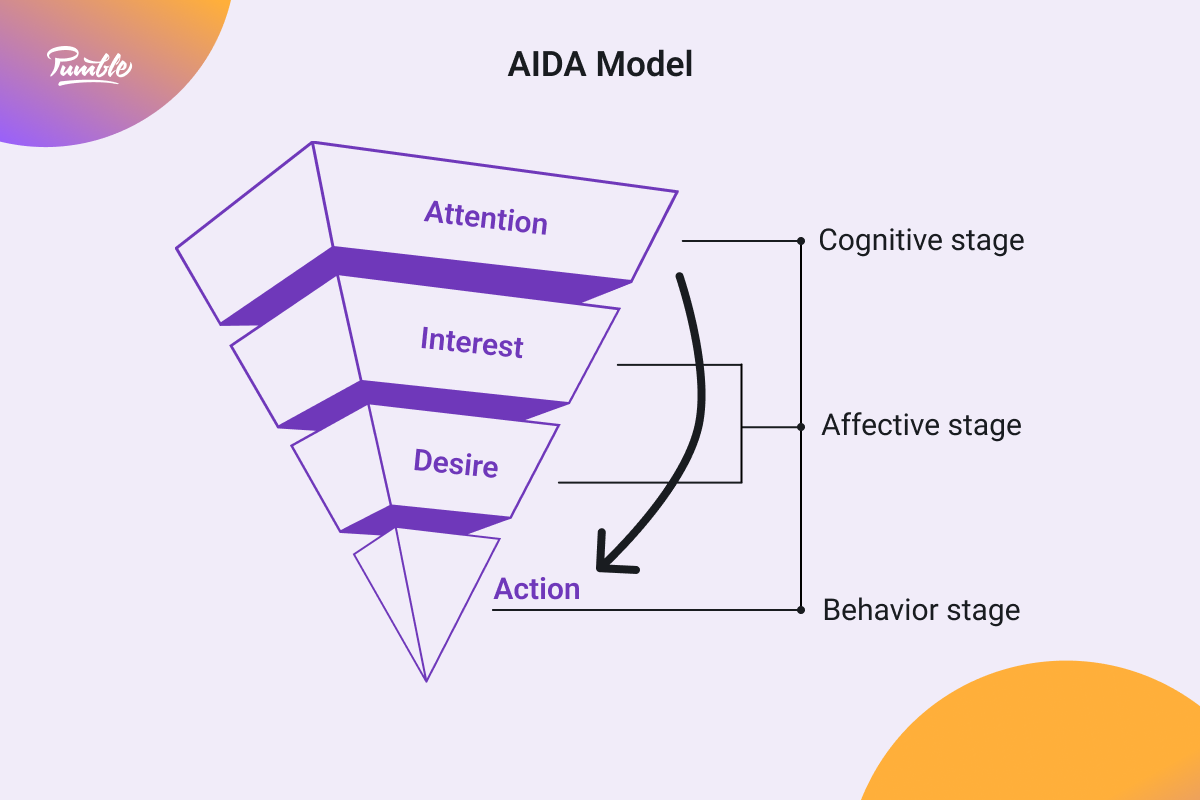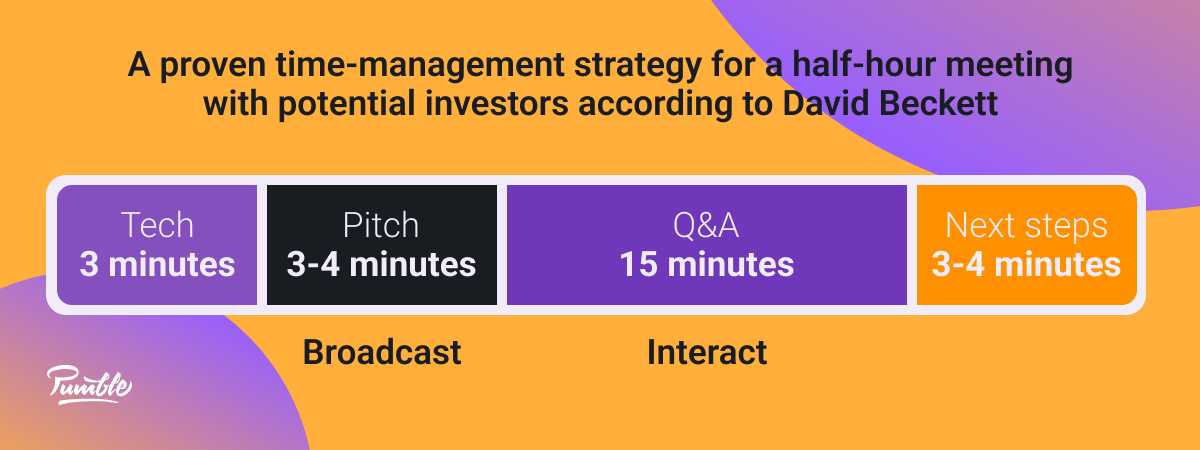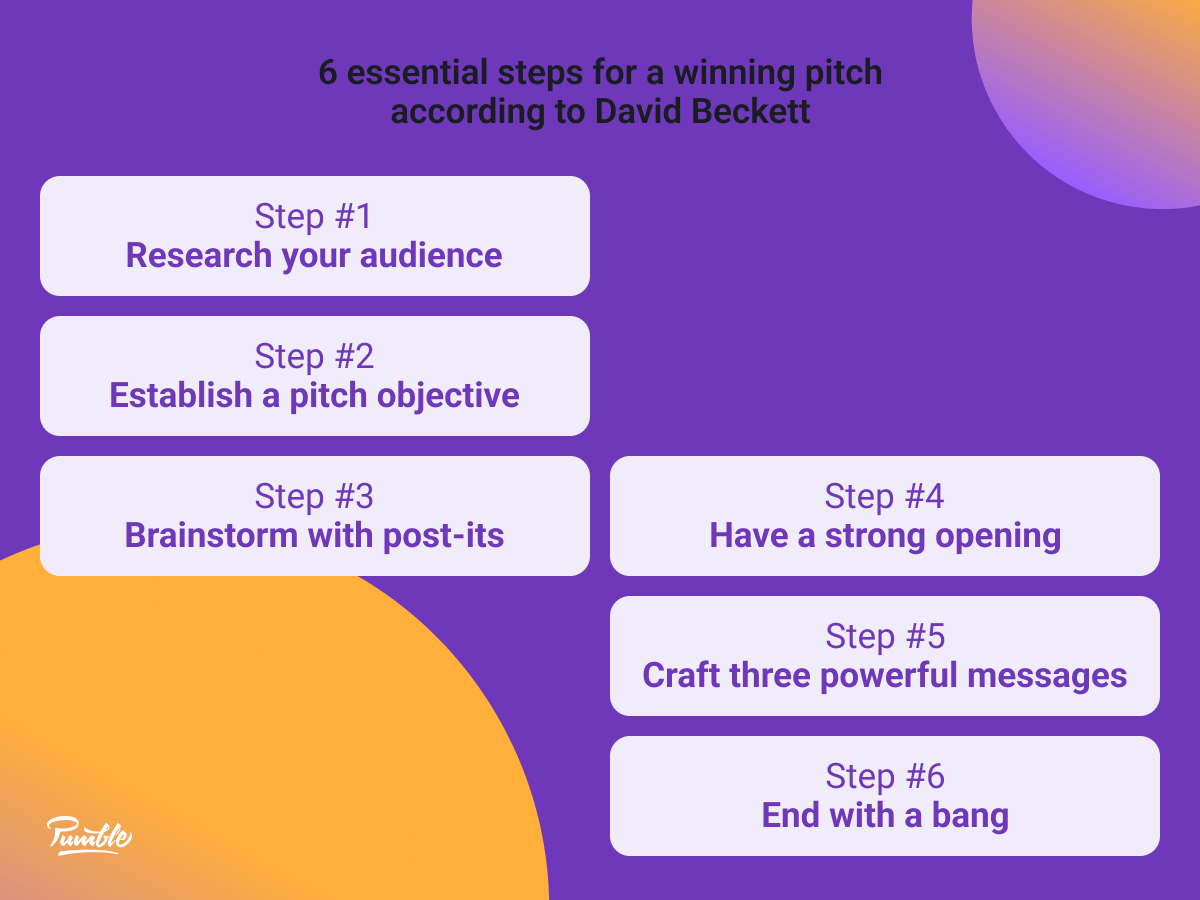Despite the common belief that having a valuable idea is a key to success, even a great idea is worthless unless you know how to present it effectively.
Whether you’re pitching to your colleagues, investors, or prospects, you need to showcase your idea strategically to make a positive impression and improve the likelihood of achieving your objectives.
So, to help you pitch your business ideas successfully, in this blog post, we’ll cover:
- What an effective pitch implies,
- Why making a great pitch is critical,
- How long your pitch should last,
- The key steps you need to take to make your voice heard, and
- Tips and tricks of pitch experts.
Let’s elevate your next pitch!

Table of Contents
What is a pitch?
A business pitch is a short presentation of a business idea to those who are involved in the decision-making process.
You can pitch your ideas to various stakeholders such as:
- Investors,
- Potential customers, and
- Your team members.
Thus, depending on the audience and objective, we can identify different forms of pitches. The most common types are the following:
- An investor pitch: The purpose is to persuade potential investors to invest funds in your business idea.
- A sales pitch: The objective here is to persuade your potential customers to take the desired action, which helps you move them to the next step in your sales process.
- An internal pitch: The pitches inside a company, typically to propose innovations or communicate change at the workplace.
Regarding the length of a pitch, there are three main types of investor pitches:
- An elevator pitch: A concise and compelling one-minute pitch that includes a key message or two with the purpose of connecting with the audience.
- A short-form pitch: It lasts usually from three to ten minutes.
- A long-form pitch: Typically, it shouldn’t last more than twenty minutes.
According to Marie Perruchet, an experienced pitch coach and the author of the book One Perfect Pitch: How to Sell Your Idea, Your Product, Your Business―or Yourself:
“Pitch is a human connection, not a PowerPoint deck or a number of megabytes.”
She adds:
“Good pitches are succinct stories. They are fractals of your larger story. All this preparation is necessary to enable you to tell better stories that will let people connect with you.”
Therefore, making a winning pitch requires much more than presenting information ― primarily, it’s about resonating with your audience and increasing their level of engagement.
💡 Pumble Pro Tip
If you are curious to learn about how to utilize different presentation types and styles, check out our blog post:
Why do you need a great pitch?
As David Beckett, an experienced pitch trainer who helped over 1600 startups raise over €400 million in investment and coached over 28,000 professionals on how to make winning pitches, said:
“Talented people with great ideas that can change lives may never be heard.”
Knowing how to create a winning pitch is equally important as the value of your idea.
Most importantly, your pitch should engage with your listeners in 3 interconnected ways:
- Cognitively ― firstly, you need to get your point across and clarify your idea and value proposition.
- Emotionally ― secondly, your pitch should evoke the right emotions at the right time to make a greater impact.
- Behaviorally ― only when you trigger your audience’s emotional responses can you expect them to take a certain action that reflects your pitch objective.
Namely, a great pitch goes beyond presenting your idea ― along with conveying the right information to your audience, you need to resonate with them and encourage them to take action.
In other words, you need to convince your listeners of your idea or spark their interest to know more.
Perruchet highlights that pitches need to encapsulate the larger story of your idea. Therefore, it’s necessary to tell a short version of a compelling story that will make your audience connect with your idea and, ultimately, delight them to take a certain action.
Considering the three aspects of pitches, we can conclude that we should improve our pitches due to the following reasons:
- A great pitch grabs the audience’s attention,
- A great pitch is memorable,
- A great pitch evokes the right emotions, and
- A great pitch persuades the audience to follow the idea.
So, let’s analyze each of these reasons.
Reason #1: A great pitch grabs the audience’s attention
The only way to make sure people listen to your idea is to get their attention and interest early on.
Thus, successful pitches demand communicating from the audience’s perspective ― they need to be structured in a way that attracts and holds people’s attention.
Also, according to marketing models such as AIDA, the first step in a buyer’s journey is an awareness or attraction phase.
This is the unskippable step that leads toward the interest and desire phases, where people are emotionally connected with the idea.

Reason #2: A great pitch is memorable
In her book, Purruchet outlines that after a pitch, people retain only 10% of what they have heard.
This is the reason why great pitches are easy to digest, so people can remember and share critical information.
Additionally, adding a personal touch and sharing your passion makes a pitch more memorable and relatable.
Reason #3: A great pitch evokes the right emotions
Why is triggering the right emotions vital for the success of every pitch?
According to the Annual Review’s study, emotions constitute persuasive and predictable drivers of the decision-making process.
Therefore, to ensure your listeners follow your idea, make your pitch an exciting journey that evokes strong emotions.
Considering the AIDA model of buyers’ journey, interest and desire stages are an affective phase where potential customers build an emotional connection with the brand or product. Here, they move from liking to wanting ― so, they are a step away from taking action.
Reason #4: A great pitch persuades the audience to follow your idea
Every pitch has an objective ― most importantly, their realization always depends on the audience’s response.
That’s why a winning pitch is persuasive and instrumental in encouraging listeners to take the desired action.
So, we can draw a parallel between a business pitch and a marketing funnel that represents a buyer’s journey through different phases.
We can identify the AIDA model phases in business pitches:
- Attention or attraction,
- Interest,
- Desire, and
- Action.
Hence, a presenter has a task to attract and delight the audience, and ultimately, engage them with their idea to make it a reality.
Here’s what Dr. Raffaello Antonino, a Senior lecturer in Counseling Psychology, has to say about the power of great pitches:

“A well-crafted pitch can help you stand out in a crowded market, differentiate yourself from the competition, and demonstrate your potential for success, even if the idea itself isn’t more revolutionary than the others.”
💡 Pumble Pro Tip
Using interactive elements and a story framework is undoubtedly the most effective way for boosting the audience’s engagement and increasing their attention span. To learn more about how to make your presentation interactive, make sure to read our blog post:
Host interactive and engaging virtual presentations over Pumble
How long should your pitch last?
Before we reveal the most effective steps for making a powerful pitch, let’s discuss one of the most important questions ― What is an optimal pitch duration?
According to David Beckett, the author of Pitch To Win, and the creator of the Best3Minutes Pitch Methodology, pitches shouldn’t last more than 7 minutes. This especially applies to investor pitches.
One of his core principles of making a winning pitch implies the following 3 criteria:
- Simplicity,
- Clarity, and
- Focus.
Beckett outlines: “It’s about what you take out of your pitch, not what you put in”.
He also highlights the most common mistake when it comes to companies’ pitches ― they make too long presentations, so they prioritize what they want to say instead of whether their audience will listen to their speech.
That’s why Beckett advocates elevator and short-form pitches ― 1–3-minute pitches that get to the essence of the story.
Furthermore, here’s what Perruchet points out in her book:
“The shorter your story is, the more interesting it will be. If you focus on the bare essentials and distill exactly what your business is, the problem it solves, and the transformation it promises, that’s what will separate you from the others. A story in the entrepreneurial world needs to fit into a short format: 60 seconds, 5 minutes, or 10 minutes.”
Therefore, there’s no universal ideal length of a pitch, but typically they should last about 10 minutes or less.
How to structure long-form pitches?
On the other hand, some types of pitches demand more time.
According to the Forbes article, even in this case, your pitch shouldn’t last more than 18 minutes.
Namely, TED organizers have discovered that longer pitches are ineffective ― too long presentations can lead to information overload, which can cause exhaustion and decrease you listeners’ engagement.
Ideally, long-form pitches should last about 10 minutes, but 18 minutes is acceptable when a video or demo is included.
When you give a long-form pitch or presentation, the most important thing is to structure your time wisely.
According to Beckett, to pitch your startup to investors successfully in a half-hour meeting, you should follow a proven time-management strategy structure:
- Tech setup ― approximately 3 minutes,
- Pitch ― 3–4 minutes,
- Q&A session ― around 15 minutes, and
- Next steps ― around 3—4 minutes.
Surprisingly, you should spend approximately 90% of pitching time on Q&A sessions, so your audience has a chance to interact with you.

Once you finish the initial pitch, it’s a good moment to open a discussion session ― ask your potential investors what they would like to know more about.
Every investor has different perspectives and priorities ― by asking this question, you can easily adapt your speech.
Some of them might be primarily interested in your product, while others may focus more on customers and their needs. Some may even be oriented toward re-engaging already-purchased leads. Consider what may apply to the person you’re pitching to.
Therefore, keep in mind these two things when planning a long-form pitch:
- Good time management is more than half of success.
- Your audience wants to be heard, so create space for interaction.
How to make an impactful pitch in 6 key steps?
To give a winning pitch, you have to follow these 6 essential steps:
- Research your audience,
- Establish a pitch objective,
- Brainstorm with post-ins,
- Have a strong opening,
- Craft three powerful messages, and
- End with a bang.
So, let’s learn how to master pitching skills with these steps and discuss each of them.
Step #1: Research your audience and competitors
“Communication is what the listener does. It’s not always about the story that I want to tell, but you want your audience to take action.”
― David Beckett
Most presenters make a huge mistake by focusing solely on their stories and neglecting their listener’s perspectives.
However, the only way to achieve your pitch objective is to understand your audience and connect with them.
That’s why the first essential step for making a great pitch is researching your audience.
Beckett suggests finding answers to these and similar questions:
- What drives your audience?
- What are their needs and interests?
- What’s on their mind?
- Are they interested in money or sustainability?
- Are they theoretical or practical?
- Are they conservative or innovative?
If you’re pitching to potential customers, attempt to identify:
- Their biggest challenges or problems, and
- What they focus on ― saving cost, growth, or something else.
Knowing your audience helps you simplify and organize your story and select the relevant information that your audience needs to know.
Lecturer of marketing and TEDx speaker, Matthew A. Gilbert, highlights the importance of communicating the value of your business idea to the audience:

“The most vital part of pitching a business idea is demonstrating its value to your potential investor or partner. In other words, what’s in it for them? Know your audience as well. Some might be intrinsically motivated by your mission, whereas others are focused on its extrinsic value.”
Apart from researching your audience, it’s a good idea to research your competitors.
According to Perruchet:
“Knowing the competition enabled us to prepare well. We were able to take a different tack on the product and the brand story. As a business owner and as an entrepreneur, you always want to be ahead. Knowing what your competitors are up to is a survival skill.”
Our contributor and PR professional, Julie Livingston, shared her view on this topic:

“The first step in developing a business pitch is research to deepen understanding of the competitive landscape and key stakeholders’ needs. How will your idea address their pain points?”
Therefore, before you start making a pitch, make sure to invest some time in researching, which can dramatically improve the outcome of the pitch.
💡 Pumble Pro Tip
Not sure how to effectively prepare your next business presentation? Check out our guide:
Step #2: Establish a pitch objective
Aside from researching your audience, it’s critical to identify what you want them to do ― in other words, what action you want them to take.
Try to be as specific as possible about your pitch objective.
Most importantly, keep in mind that here we’re talking about the pitch objective, not your ultimate objective.
For instance, if you pitch your business idea to potential investors, your ultimate goal is to get their funding.
However, it’s not realistic to expect to achieve so after your initial pitch.
But, your pitch objective can be a one-hour follow-up meeting, which can help move you closer to your bigger goal ― in this case, getting funding.
If you deliver a sales presentation to people who have never heard of your brand before, you may want your audience to visit your website and fill in the survey.
On the other hand, if you pitch to people who have engaged with your brand, your pitch objective here is to get people to buy from you.
So, there are two major rules when setting your pitch objective:
- Define the action your audience is supposed to take in detail― Not what you want them to think or feel about your idea, but what specific action they are supposed to take.
- Define a realistic pitch objective ― If your audience has never heard of you, you can’t expect to get them to purchase your products as a result of the pitch. In this case, establish a pitch objective that will get them closer to your ultimate goal.
Step #3: Brainstorm with post-its
Once you research your audience and establish a pitch objective, it’s a good time to start brainstorming.
Even though all presenters understand the importance of pitch preparation, most of them do it completely wrong.
Beckett recommends getting a pitch out of your head ― instead of starting by creating presentation slides and graphics, the first thing you should do is get all your ideas and put them on post-its.
So, put your all ideas on post-it notes ― everything that comes to your mind about:
- The problem you’re solving,
- Product,
- The team, etc.
This way, you can organize your ideas and thoughts in clusters, so you can have chapter headings, which ultimately help you make a storyline.
Once you have a storyline, you can begin crafting presentation slides and visuals yourself or partner with a pitch deck design agency for a professional assistance.
Structure and brainstorm your pitch on Pumble
Step #4: Have a strong opening
Beckett says that people who listen to your pitch have two questions on their minds:
- Is this person professional?
- Do I want to know more about the idea?
To demonstrate your professionalism, you need to have a plan from the first sentence of your pitch.
Beckett recommends starting with concrete sentences that grab the audience’s attention and motivate them to listen carefully to what you have to say.
Instead of starting by saying how you’re excited about this opportunity, get to the point as soon as you start your pitch.
For example, you can say who you are and what the value proposition of your business is, or present interesting facts about the challenge your business can help them overcome.
Here are the good practices for opening a pitch:
- Quantify the problem you’re solving,
- Get early traction, and
- Get the audience straight to the story.
Way #1: Quantify the problem you’re solving
Here’s what Beckett says:
“If you have a parking app, you could say: “Parking is quite difficult, so we’ve built an app for that”, and then tell them about technology. But, nobody would be excited about that technology.
Instead, you can put the number on it. You could say: “Did you know that on average, it takes people over 20 minutes in large cities to find a parking space? Did you know that over 30% of all exhaust fumes in major cities are caused by people looking for parking? And could you imagine you’re gonna spend 1 year of your lives looking for a parking space?”
If you do that, you help people understand very specifically what’s the problem and what’s the size of the problem.”
So, the key practice here is to be very specific. For example, instead of using generic statements such as “many people”, highlight the exact number or percentage.
Way #2: Get early traction
Talking about your traction at the very beginning of the pitch is a good way to establish your credibility.
For instance, if your business has already acquired sales, you can briefly explain why your customers are buying your product. This way, you can change your audience’s mindset by letting them know that your business has been successfully running. So, instead of thinking whether this type of product is a good idea, they start to think about how this can develop in the future.
On the other hand, if you still don’t have customers, you can take advantage of the problem validation.
For example, you can say that you’ve conducted customer interviews or research that revealed that people demand the type of product you’ve created.
Way #3: Get the audience straight to the story
The third way to start your pitch is to get straight to the story you want to tell. You can simply start with a short introduction of your business and tell what problem or challenge you’re dealing with.
This way, you demonstrate your professionalism and show that you respect your and your audience’s time.
💡 Pumble Pro Tip
If you want to learn more about how to professionally start your presentation, make sure to read our blog post:
Step #5: Craft three powerful messages
Even though you might think you should tell your listeners as much as you can, the number one rule is: less is more.
This is not just about the time, which is most likely your biggest enemy when giving a pitch ― this is also about the limitation of human information processing.
Namely, studies on cognitive capacity limitations show that most individuals can retain up to 4 items at once.
Therefore, Beckett suggests “using a power of three” ― breaking down the story into the three most important messages you want your listeners to remember.
Furthermore, you should choose up to three key points for each chapter of your pitch that your listeners need to retain.
Chapters for a winning investor pitch
According to Beckett’s Pitch canvas (brainstorming tool for startups), aside from a strong opening statement, a successful investor pitch includes the following chapters:
- The problem ― To get investors interested in your business, you need to provide answers to these questions:
- Does this problem exist?
- How big is the problem?
- Will people buy this product?
- Have you validated that?
- Your solution ― Briefly state how your product serves customers and how it works.
- Product demo ― According to Perruchet:
“Get to the demo as quickly as possible. If you have built an application or a platform or if you have a prototype to show, this is the time to show it. If you don’t have the product to show, tell a customer story.”
She states that presenters shouldn’t spend much time on demos:
“For a 1-minute pitch, make it 10 seconds. For a 20-minute presentation, keep it under 2 minutes.”
- Unique value proposition ― Briefly describe how your business stands out from competitors.
- Customer traction ― Talk about your pilot customers, or use data and facts that validate your product.
- Business model ― Tell about the mechanism that turns your idea into money or mention growth opportunities.
- Investment ― State whether you’ve invested any money, how much money you’re raising, and what milestones money will help you reach.
Here’s what Caroline Hoffmann, communications and PR expert, adds on this topic:

“You should have a solid business plan as investors are more and more careful with how they invest their money and take less and less financial risks.”
- Team ― Tell about your team’s strengths.
- End statement with a call to action ― End with a powerful one-sentence summary and a clear call to action.
- Why you? ― Briefly highlight your motivation for the business.
Step #6: End with a bang
Becket says:
“The last thing you say is the first thing they will remember”
Hence, a strong closing of your pitch is equally important as a strong opening.
This phenomenon is known as the serial position effect — a cognitive bias that results in people remembering the first and last items in a series best.
Far back in 1885, in the book Memory: A Contribution to Experimental Psychology, psychologist Hermann Ebbinghaus described this tendency, which inspired scientists to research further.
Ray Ehrensberger wanted to apply this evidence to public speaking. His experimental study reaffirmed the effect of primacy and recency ― when listening to public speeches, people tend to recall the first and last information easier than information in the middle.
Moreover, in this experiment, information delivered at the end of a pitch had the highest level of recall.
Therefore, the conclusion of your pitch is critical because it sticks to your listeners’ minds, and impacts their further actions.
To make a strong closing, Beckett advises:
- Give your audience a one-sentence summary of your pitch,
- State a call to action, and
- Thank your listeners.
To give people an effective one-sentence summary, Beckett strongly recommends choosing three points that reflect the three most important messages you want your audience to remember.
For instance, you can briefly state:
- The problem your business is solving,
- The unique value proposition, and
- The qualified team that makes things happen.
After that, you need to state a call to action ― tell them directly what you want them to do as a result of the pitch.
For instance, you can tell them to send an email to organize a one-hour meeting or visit your website and download the ebook.
Finally, once you call them to action, it’s a good time to thank them.

So, let’s summarize all DOs and DON’Ts for pitching a business idea.
| ✅ DOs | ❌ DON’Ts |
|---|---|
| Set a realistic and specific pitch objective in terms of the action your audience is supposed to take as a result of the pitch. | Don’t set a vague objective such as “make the audience like or support the idea”. |
| Brainstorm your all ideas and organize them into headings, which will help you make a storyline. | Don’t start making a presentation and creating graphics before brainstorming and organizing ideas. |
| Start with a strong and concrete opening sentence. You can use the following ways to do so: – Quantify the problem you’re solving, – Get early traction, and – Get the audience straight to the story. | Don’t waste your time with unnecessary introductions such as: “Thank you for this opportunity, I’m really happy to have a chance to pitch my idea today…” |
| For each chapter, choose no more than three key messages you want your audience to pay attention to. | Don’t include too many details that can easily lead to informational overload. |
| End with a strong summary you want them to remember. After that, directly call to action and thank them. | Don’t just thank them without an effective ending sentence and a direct and clear call to action. |
5 tips for elevating your pitch from good to great
Now that you’re familiar with the essential steps in making a great business pitch, let’s discuss some powerful tips on how to improve the effectiveness of your pitches.
Tip #1: Learn the first minute of your pitch
Fear is a natural response in a public speaking setting.
There are different reasons why people might feel anxious ― it can be the fear of saying something embarrassing or mind-blanking.
To cope with these and similar fears, learning the first sentences of your speech is a lifesaver.
This way, you send a message to your body and mind that everything is under control, which improves your confidence and helps you focus on what you’re speaking.
💡 Pumble Pro Tip
Approximately 75% of the population is affected by fear of public speaking. To learn more about how to cope with it before, during, and after holding a presentation, make sure to read our blog post:
Tip #2: Make your pitch more human
We’ve already discussed the importance of evoking investors’ or customers’ emotions and the most effective way to do so is to make your pitch more human.
When you give a human touch to your pitch, you empower your audience with empathy, which can help you to strengthen your relationship.
Beckett points out two effective approaches to achieve this:
- Talk about the pain in a more human way, or
- Put yourself in the story.
So, let’s dig deeper into these two approaches.
Approach #1: Talk about the pain in a more human way
As we mentioned earlier, talking about the problem your business solves is one of the key moments in your pitch, because it makes a context for your business idea.
To get your audience to relate closer to the problem, you need to use a story framework.
The good way to do so is to talk about the experience of your typical customer ― present their obstacles and frustration caused by the problem.
This way, your audience can empathize with the typical customer, which helps them realize how frustrating or big the problem is.
Approach #2: Put yourself in the story
It might happen that you’ve experienced the problem your business solves. If this is the case, don’t forget to include your personal experience in the story.
This is undoubtedly appealing to all investors and customers.
Considering psychological studies, Perruchet states:
“We aren’t truly affected by a story unless we are emotionally transported, unless we lose ourselves in it. Stories strike an emotional chord, and sharing a personal moment that most of us can relate to makes for a universal story.”
After a human touch that will elevate your pitch and connect your audience to the story, it’s a good moment to add a rational part. Use statistics and data to highlight how widespread the problem is.
Tip #3: Communicate your emotions and passion
One of the crucial things you should be aware of is that the non-rational part of your pitch is as important as the rational.
So, even though your potential investors or customers want to know about your business, unique value, team, and business model, they also want to see passion and commitment.
That’s why Beckett says:
“If you want them to come on board and support you, or even invest in your idea, your pitch needs to connect with them in the head and the heart.”
According to him, many investors revealed that answering the following questions makes a dramatic impact on their final decision:
- Why did you decide to solve this problem?
- Why do you want this problem solved?
- Why do you think your product is unique?
- What things make you excited about the product?
So, even if you’re not an extrovert, try to think about something about your idea that makes you happy and excited.
This way, you can easily convey your passion and enthusiasm, which your potential customers or investors will recognize.
As a result, they will trust in your idea and get motivated to take action.
Express your emotions clearly and effectively over Pumble
Tip #4: Convey certainty
In connection with the previous tip, one of the great factors to make people trust you is certainty.
Beckett claims that certainty helps pitchers generate confidence in their audience, so they can connect and trust your idea.
After all, nobody will believe your idea unless you believe it.
Perruchet suggests that confidence comes from researching and knowing your target audience and your product. Here’s what she adds on this topic:
“Get rid of “unconfident” words. Using “I think” or “I’ll try” implies indecision and uncertainty. Tell people what you are doing, not what you are trying to do. If you currently are not doing it, say how you are going to execute, build, or develop it.”
Tip #5: Create a conversation
According to the Harvard Business Review’s survey: “Few decision-makers want to be ‘pitched.’ They want you to listen to them, ask questions, and understand their point of view on their problem before hearing your solution.”
As we’ve already discussed, a Q&A session should take up the most amount of time, so you can adapt your pitch to your audience’s interests.
Aside from considering their interests, remember to adapt your word choice.
Here’s what Caroline Hoffmann has to say about this topic:

“If you’re pitching people who are not from your industry, make sure to adapt your speech and wording so they can easily understand complicated technologies, concepts, components, etc.”
So, even though you’re a pitcher, the real star here is your audience ― so, turn your pitch into interaction.
Pitch your ideas over Pumble
An all-in-one communication tool like Pumble can help you hone your pitches and send them to their intended recipients.
For example, Pumble’s channels and direct messages are great for internal pitches intended to propose innovations within a company or a team.
On the other hand, Pumble also has a guest access feature that allows you to invite external contributors, like potential partners or investors, and pitch your ideas to them.
Pumble can support you throughout the entire pitching process. You can pick the medium in which you want to pitch your idea — maybe you’re more of a voice call fan than you are a meeting person — as well as the features you want to use to make your pitch perfect.
If you opt for a video meeting, Pumble will enhance your pitch efforts with features like:
- Screen sharing, giving you many opportunities to provide additional explanations or illustrate your plans,
- File sharing, that allows you to send any additional CTAs of files of any size after the meeting, and
- Meeting recording, that allows you to go over your pitch for future reference.








